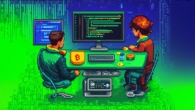
Will NFTs ever bounce back

Why Did NFTs Lose Steam?
One of the main factors contributing to the decline of NFTs is their high price point. When NFTs first hit the market, they were being sold for millions of dollars, which made them inaccessible to most people. This led to a lack of interest from collectors and investors, as well as criticism from those who saw NFTs as overhyped and speculative investments.
Another issue with NFTs is that there are no clear guidelines or standards for their creation and sale. This has led to confusion and uncertainty around the value and authenticity of certain NFTs, which has further turned off potential buyers and investors. For example, some NFT creators have been accused of using fake or manipulated data to create their digital assets, leading to questions about the integrity of the entire market.
Finally, there have been concerns about the environmental impact of NFTs. The process of creating and selling NFTs requires a significant amount of computational power and energy, which has raised questions about their sustainability and long-term viability. For instance, some NFT creators have been accused of contributing to climate change by consuming vast amounts of electricity in the process of creating and selling their digital assets.
Recent Developments in NFTs
Despite these challenges, there have been some recent developments in the NFT space that could help them regain momentum. One such development is the creation of decentralized marketplaces for buying and selling NFTs. These marketplaces are built on blockchain technology, which provides a secure and transparent way to authenticate and verify NFTs.
For instance, platforms like OpenSea, Rarible, and SuperRare allow creators to mint and sell their digital assets directly to buyers, without the need for intermediaries. This provides a more direct and transparent way for creators to monetize their work, while also giving buyers greater control over which NFTs they purchase.
Another development is the creation of more accessible NFTs that are priced at a lower point. These NFTs can be created using a variety of different media, including images, videos, and audio files, and can be sold for a fraction of the price of more expensive NFTs. This could help to democratize the NFT space, making it more accessible to a wider range of people and use cases.
Finally, there have been efforts to address the environmental impact of NFTs. For example, some NFT creators are using carbon offsetting to neutralize the energy consumption associated with creating and selling NFTs. This could help to alleviate concerns about the sustainability of NFTs, which could be a major barrier to adoption in the future.
Summary: Will NFTs Ever Bounce Back?
It is difficult to say for certain whether NFTs will ever bounce back and become a mainstream technology. However, based on the developments we have seen so far, it seems that there is some potential for growth and adoption in the space. Decentralized marketplaces, more accessible NFTs, and efforts to address environmental concerns could all help to move the needle in the right direction.
FAQs:
What are NFTs?
NFTs, or non-fungible tokens, are unique digital assets that can be used to authenticate and monetize digital content. They are typically stored on a blockchain, which provides a secure and transparent way to track ownership and transfer of the asset.
Why did NFTs lose steam?
There are several factors that contributed to the decline of NFTs, including their high price point, lack of clear guidelines or standards for creation and sale, and concerns about their environmental impact. These challenges have led to a lack of interest from collectors and investors, as well as criticism from those who saw NFTs as overhyped and speculative investments.
What are some recent developments in NFTs?
Recent developments in NFTs include the creation of decentralized marketplaces for buying and selling digital assets, the development of more accessible NFTs at a lower price point, and efforts to address environmental concerns associated with NFTs. These developments could help to move the needle in the right direction and increase adoption of NFTs.
What is the future of NFTs?
It is difficult to predict the future of NFTs with certainty. However, based on the developments we have seen so far, it seems that there is some potential for growth and adoption in the space. If NFTs can be shown to have real-world value and use cases beyond just digital art and collectibles, then they may have a chance at long-term success.







